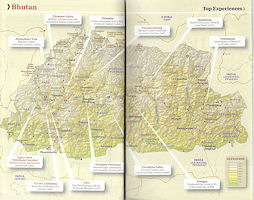
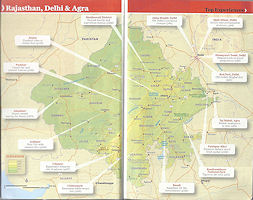 |
Delhi, India

 |
Delhi, India
A spectacular holiday this year. We started with two full days in Delhi, the large and busy capital of India. In New Delhi you can find buildings as the India Gate, commemorating the victims of amongst others World War I, Humayun's tomb with not only his tomb, but also of a number of unknown people, and the large Sikh temple where free meals are served three times a day to about 25,000 people.
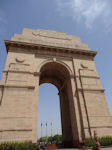 |
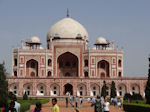 |
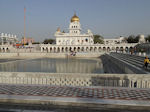 |
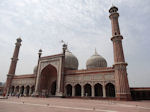 |
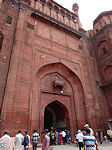 |
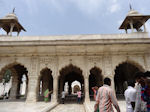 |
After these two days we flew to Paro International Airport in Bhutan, a country that is not very frequently visited by foreigners. Since it was already late in the afternoon we drove right away to the capital of Bhutan, i.e. Thimpu, where we stayed in the nice Namgay Heritage Hotel, with its beautiful hanging lamp in the central hall.
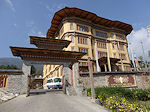 |
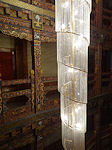 |
Thimpu has many interesting places like the Tibetan-style National Memorial Chorten, the very new and very huge Buddha and the National Library, an archive where many ancient Buddhist papers and texts are kept. It is exceptional, but even in a wheelchair you can visit Bhutan and with help of our friendly guide Sangay and driver Younten Jaap could see many buildings, although he couldn't enter all of them because of steep stairs and steps. But rolling around is possible, especially with some help.
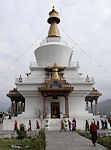 |
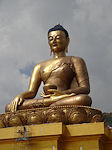 |
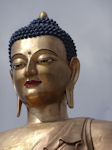 |
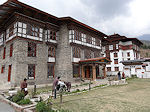 |
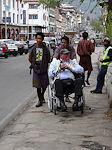 |
There are no traffic lights in Bhutan. The one they had in Thimpu has been replaced again by a life and personal police man who is handling the sometimes busy traffic of the modern and western cars.
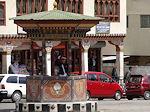 |
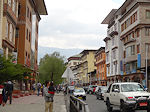 |
The most important building in Thimpu is undoubtedly the Thimpu dzong; both of monastic and regal importance. From a viewpoint a bit higher on the mountain you have a great view over the enormous buildings. One part of the dzong is the administrative section and the other part is for the monks. Entrance to the main central tower is only allowed to the king, the former king and the head of the monks. The dzong can only be visited by tourists after working hours.
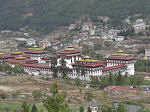 |
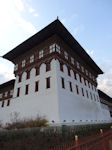 |
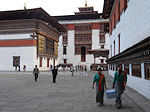 |
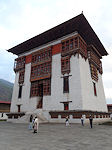 |
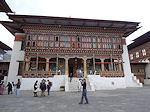 |
The road to Gangtey is closed for several hours during the day due to road widening works and people are waiting patiently during that time. After the road was open again we passed Dochu La (pass) where Sangay hanged up some prayer flags for us. We did do the same ourselves on the cold Lowa La.
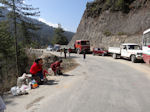 |
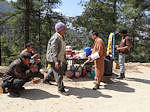 |
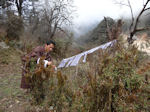 |
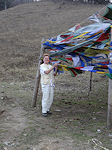 |
In Gangtey in the Phobjikha Valley we stayed overnight in the very nice Dewachen hotel. Since the area is at 2,900 meters it can be very cold at night, even in April, and all rooms have their own stove burning on wood. You can cook water on top of the stove that can be used in a hot water bottle for in your bed. The Phobjikha Valley is the place where in October/November the black-neck cranes come to winter here. The valley is one of the most important wild life preserves in Bhutan.
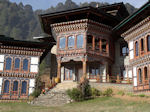 |
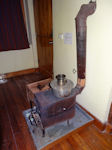 |
The Gangte(y) Goemba is a beautiful monastery. The prayer hall is one of the biggest in the country and has painted walls and very nice wood carvings. On one of the corners of the prayer hall is one of the holy animals of Bhutan, i.e. Garuda.
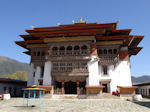 |
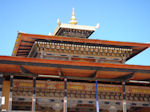 |
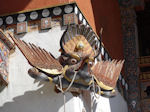 |
On the way to Trongsa you pass Pela La at an altitude of 3,420 meters, so time for hanging up prayer flags. Others had done so before us :-) Even on top of the mountain there are prayer flags.
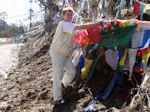 |
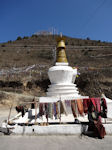 |
Trongsa is in the middle of Bhutan and is a sleepy and pleasant village. However, the dzong is of great importance. Every crown prince has to spend here at least a year to govern the province and to learn how to reign the country. From the viewpoint at the other side of the valley there is a very fine view over the dzong and the village. You enter the dzong over a small wooden bridge. In the dzong are many steps and stairs, lovely courtyards and many buildings. There are nice paintings too, e.g. Guru Rinpoche's Paradise.
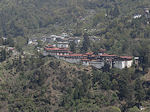 |
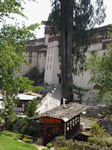 |
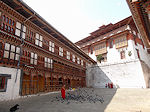 |
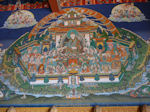 |
The former Trongsa dzong watchtower, on a hill above the dzong, is nowadays the Trongsa museum and has many royal memorabilia. There are several floors with displays and historic information. From the top of the tower views over the dzong and the valley are magnificent.
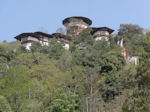 |
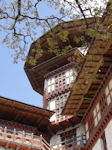 |
Between Trongsa and Punakha the road goes again via Pela La through narrow greenish valleys , a favourite place for the Himalayan yaks. We saw many of them, sometimes only a meter away from our car.
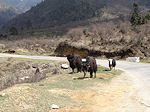 |
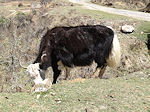 |
Halfway our trip, not far from the in 2011 burned down dzong of Wangdue, we had a great lunch at the terrace of a restaurant in Nobding. The food was delicious, everything was freshly made for us, the views were wonderful and the service great. The terrace consisted of our table and some pieces of wood to be used as tables and chairs.
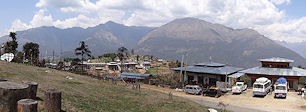 |
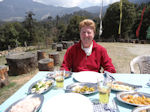 |
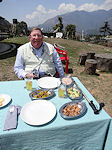 |
Punakha is famous for its dzong. The dzong has been built on the junction of the Mother and the Father river and is said to be the most impressive and beautiful dzong of Bhutan. Entrance is over a wooden bridge and very steep stairs to protect the building from intruders. In the southern part of the dzong is the temple where remains of two for Bhutan very important men are preserved, i.e. of the first Zhabdrung, Ngawang Namgyal, the founder of Bhutan, and of Pema Lingpa, finder of Guru Rinpoche's texts and artefacts. Wall paintings and wood carvings belong in our opinion to the most beautiful ones we have seen.
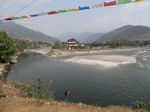 |
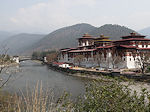 |
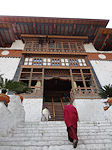 |
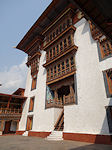 |
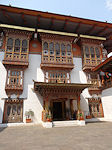 |
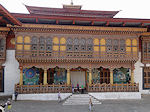 |
A few kilometers east of Punakha towards Wangdue is the nice village of Sopsoka, where Jaap was brought down for a drink waiting for us to have lunch after we visited Chime Lhakhang, the No Dog temple. The temple was built in 1499 in honour of the divine mad man who subdued the demoness of Dochu La. The temple is also known as Temple of Fertility.
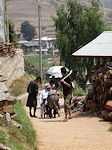 |
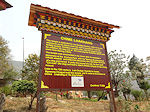 |
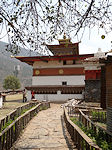 |
Further east is the rather new Nunnery with a nice temple and beautiful stupas. Unfortunately we haven't heard the nuns playing their drums.
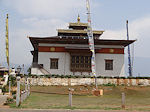 |
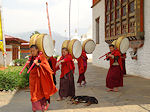 |
There are only a few roads in Bhutan and the east-west road leads via Thimpu. In the stadium there an archery contest, the national sport of Bhutan, was held and the players were very enthusiastic. It was a great pleasure to look at them playing. The distance between the players and the target is about 140 meters and if a player hits the target, his team mates praise him with a slow dance.
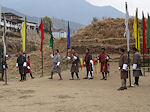 |
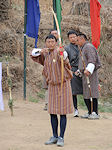 |
Along the road to Paro is a very old iron bridge, built in the 15th century. It looked very frightening to cross it, but in the end it wasn't that scary.
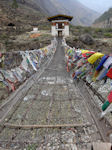 |
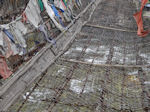 |
In Paro the annual Paro Tsechu (festival) is held in early spring and we were just in time to join it. People are dressed in their most beautiful ghos (men) and khiras (women) and the courtyard in front of the prayer hall is filled up completely. They watch the dancers and enjoy the festivities.
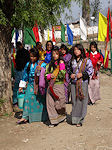 |
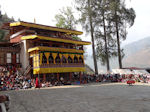 |
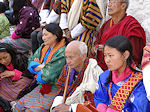 |
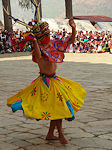 |
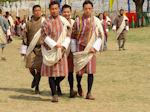 |
We had beautiful weather during our flight from Paro to Delhi and we could clearly see the Himalayas and Mount Everest. It was a magnificent view.
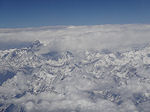 |
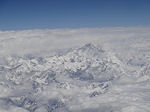 |
In Jaipur we stayed in an old palace, named Alsisar haveli, a nice place. Jaipur is also named the Pink City because of the colour of the buildings in the old city. Near the gates rickshaws are waiting to cycle people around. One of the most well-known buildings in the old town is the Wind Palace where in the past the maharanis and other ladies of the royal household could watch street life through the small windows.
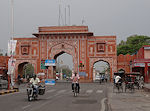 |
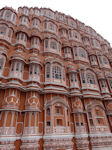 |
Jaipur is also known for its astronomy observatory Jantar Mantar, built in the early 18th century by Jai Singh, founder of the city. Every construction has its own purpose. Opposite the observatory is the City Palace, a complex of buildings and courtyards. On one of these courtyards is the beautiful Peacock gate, depicting autumn.
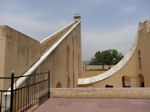 |
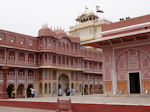 |
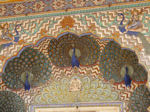 |
About 11 km northeast of Jaipur is the fort palace of Amber (pronounced Amer). It is a huge complex which can be reached by elephant or by car, like we did. The palace has beautiful buildings like the Hall of Victory with its inlaid panels and mirrored ceiling.
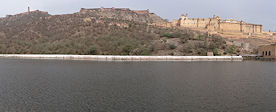 |
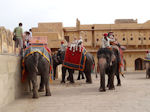 |
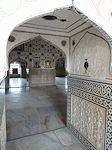 |
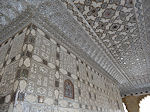 |
Pushkar is a holy place that Hindus should visit at least once in their lifetime. The town curls around a holy lake with many bathing ghats. It also has many temples and one of the world's few Brahma temples. It is a very colourful place. In October/November the annual camel fair takes place here. Then the town is jam-packed with tribal people and tourists.
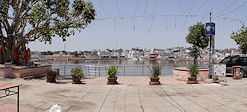 |
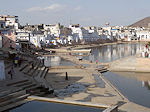 |
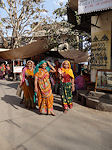 |
Because of the holiness it is hard to have meat with your dinner or alcohol. Also in the hotel where we stayed we had to have a vegetarian meal. Since Pushkar is more in the inlands rural habits still exist.
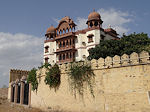 |
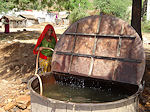 |
Udaipur is a lovely city and we stayed in a beautiful hotel, Amet Haveli, with the romantic Ambrai restaurant. Our cozy room overlooked both the City Palace and the Jagniwas Island, once decor of James Bond film Octopussy. Also from the restaurant's terrace we had great views over the city and the island.
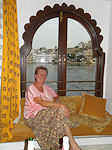 |
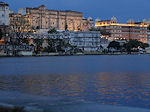 |
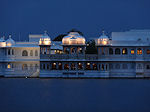 |
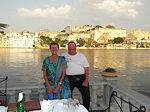 |
 |
The Jagdish temple is full of carved elephants. Even the steep flight of steps is flanked by them. The top of the temple is full of carved figures.
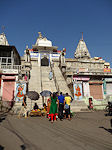 |
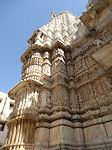 |
Close to the Jagdish temple is the City Palace, one of the top sights of Udaipur. It has lots of towers and balconies and is Rajasthan's largest palace. The construction was begun by Maharana Udai Singh II, the city's founder. The palace has a number of floors and we were very lucky that a special elevator was opened for us, so Jaap in his wheelchair could also visit all important places, like the Peacock courtyard.
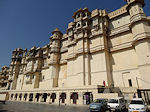 |
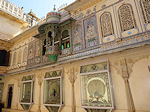 |
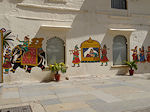 |
During a boat trip over Lake Pichola we had a nice view on our hotel and our room. It is next and left to the few steps that lead to the water and is also opposite the small swimming pool.
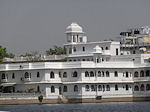 |
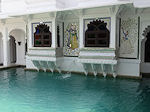 |
It is a long drive from Udaipur to Fort Ramathra, about 8 hours, and the last part of the road is rather bad. It took us about one hour over the last 25 km. More suitable for 4WD than for a 2WD car as we had. But it is worth the trouble. The fort is located between Ranthambhore and Keoladeo Ghana National Park. It has 6 rooms and 6 tents and a lovely jacuzzi on one of the little towers. Of course it also has a restaurant, since there are no facilities near by. From the fort it is possible to make a jeep safari in the area. There are lots of camel cars, nice little villages with very friendly people and lots of children.
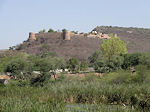 |
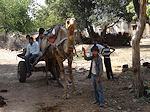 |
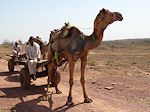 |
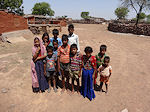 |
Including in the price of the room is a boat trip on the local lake. Take notice: before entering the boat you have to climb a long staircase and to descend over rocks to the lake. For Jaap this was not possible, so they brought him in a 40 years old jeep to another lower place, where he could enter the boat. We had a beautiful sunset trip.
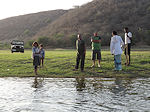 |
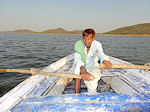 |
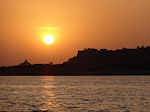 |
On the way to Bharatpur we saw some typical Rajasthani women and a nice pink tuktuk. In Bharatpur, not far from the Keoladeo NP, we stayed in the fine Laxsmi Vilas Palace hotel. The nicely decorated restaurant is in the newer Laxsmi Niwas Palace hotel, where paintings of former maharanas hang on the walls. The lovely pool is between the two hotels.
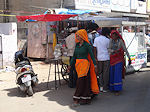 |
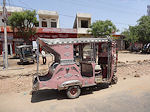 |
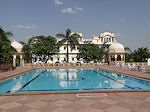 |
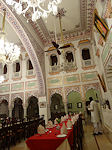 |
In the Keoladeo Park we saw not only many birds like cranes, but also antelopes and monkeys. Cycle rickshaws can take you around, but for us an electrical car was organized to show us around.
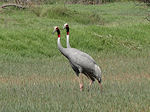 |
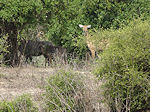 |
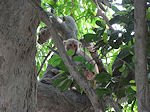 |
Before we reached Agra we visited the fortified ancient city of Fatehpur Sikri. In the time of the Mughal empire of Emperor Akbar (1571-1585) it was the capital of the area. Emperor Akbar had three wives, one a Hindu, one a Muslim and one a Christian, and they all had their own palaces and buildings.
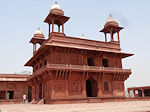 |
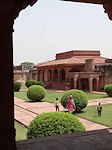 |
Beside the palace buildings lie the Jama Masjid mosque and the white marble tomb of Shaikh Salim Chishti.
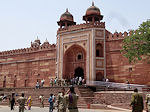 |
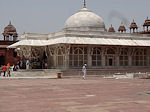 |
Going to Agra and not visiting the Taj Mahal is impossible. Shah Jahan started to build the Taj as a memorial for his third wife, Mumtaz Mahal after her death in 1631. Shortly after the complex was finished Shah Jahan was overthrown by his son Aurangzeb and was imprisoned in Agra Fort where, for the rest of his life, he could only gaze out at his Taj through a window . It is very nice to see the Taj at sunrise, though we prefer to see the building with sunshine.
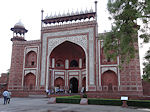 |
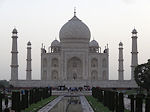 |
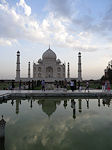 |
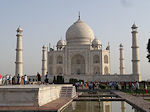 |
After our visit to the Taj and after having breakfast we visited the Agra Fort where Shah Jahan was captured for eight years in the octagonal tower. Apart from this tower there are palaces, audience halls, gates and mosques inside the fort.
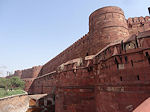 |
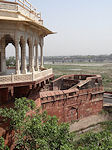 |
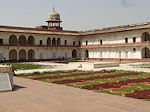 |
Itimad-ud-Daulah, better known as the Baby Taj, is the tomb of Mumtaz Mahal's grandfather. The tomb is smaller than the Taj Mahal, but arguably more refined in appearance. It was the first structure built completely from marble and the first tomb to be built on the banks of the Yamuna river. From the little building near the river you have a great view on the Baby Taj.
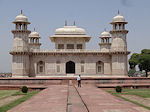 |
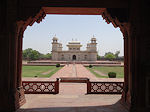 |
We had a wonderful and marvelous holiday and can recommend both countries to everyone. Bhutan is exceptional, different, and relaxed. India is noisy, busy and very interesting. Both countries are also very colourful.